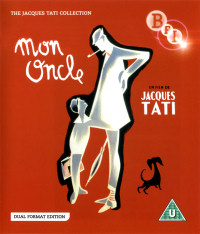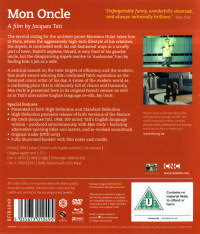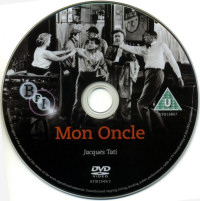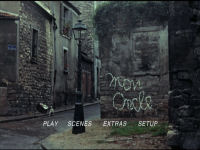
12.11.2012 #552en
von Guido Bibra
• Fully illustrated booklet with film notes and credits
![]() Der Film
Der Film
Gérad is living with his noveau-riches parents in a highly engineered and hypermodern house, but the schoolboy likes to spend his free time rather with his old-fashioned uncle Monsieur Hulot. The Arpels are not very happy about it and Monsieur Arpel, an executive in a plastic factory, wants to find a good job for his brother. But as much as Monsieur Hulot tries, he simply cannot get along with the modern world...
In the middle of the 1950s the French and European cinema was slowly but steadily beginning to recuperate from the second world war and with only two movies one director had made an invaluable contribution to it: Jacques Tati, who had created a whole new genre with his unmistakeable style. His first feature film Jour de Fête had become a great success in Europe and with Les Vacances de Monsieur Hulot he even managed to conquer America. With two popular and highly praised movies in his repertoire, it was not hard for Tati to get a new project financed.
Tati No. 3
While other filmmakers were even in those days making several movies a year, Tati took his time to extensively prepare for his new project. There was a three-year-gap between the premieres of Jour de Fête and Les Vacances de Monsieur Hulot and it took Tati even longer to get his new movie into the cinemas. At first simply called Tati No. 3, it soon became his most ambitious project and was a huge departure from his relatively modest and simple kind of filmmaking.
Tati's first step was to establish a new company to produce his movie. While his experiences with his old friend Fred Orain and their joint endeavour Cady Films were only positive, he wanted to start from the beginning and become a producer himself. Although he had only received a small on-screen credit, Fred Orain was still very much active in the background - his partner had not simply abandoned him, instead they had both amicably wound up Cady Films. The new Specta Films managed to get financial support from the two French co-producers Alter Films and Gray Film as well from Italy by Film de Centaurio, making the movie a true French-Italian co-production, which was also prominently noted in the credits.
Number 3 becomes My Uncle
Henri Marquet, Tati's co-writer on his last two movies, was not involved in the script writing process this time, but still was part of the team as an assistant director. Because Tati was an innovative script author, but not a very good illustrator, he was not able to visually record his ideas well. His new collaborateur Jacques Lagrange, with whom he had also worked on his last movie, was, however, an avid painter and did not only co-write the script, but he also illustrated it. His extensive drawings and storyboards determined the unique look of the movie so much, that Lagrange had become the inofficial production designer.
Together, Tati and Lagragne wrote a script which, like in Tati's previous movies, was indeed a collection of single sketch-like ideas, but it was now based on a more developed story, which contained several complex, interwoven plots. There was no actual main character, but the most important protagonist was again Tati's Monsieur Hulot, who had become so popular since his last appearance that it was a great pleasure for the director to resurrect him once more. This time Hulot was the eponymous Uncle of the movie and not simply an anonymous figure, but a full character, whom the audience got to know a little bit better than in his first appearence.
The actual plot of the movie is a story about two different worlds - the old-fashioned, comfortable and somewhat crumbling postwar France, which Tati had already affectionately shown in his two previous movies, and the styled, impersonal and sterile modern world. Monsieur Hulot and his nephew Gerad are the only characters of story who are bridging the two worlds, which otherwise exist totally separately and hardly take notice of another. Tati made these parallel existences one of the main themes and let Hulot walk around like a fish out of water in an environment foreign to him, producing many opportunities for funny, but also thoughtful situations.
The Return of Monsieur Hulot
While Les Vacances de Monsier Hulot had been the first appearance of Tati's alter ego, his adventures in Mon Oncle became much more famous. Tati made Hulot more mature, but also brought his eccentricity and clumsiness to its maximum. With an disarming, childlike naivety Hulot can even be forgiven for his biggest mishaps because he doesn't react foolish at all, but with more common sense than most of his fellow people. Tati had magnificently choreographed his character in every detail and transformed Monsieur Tati to a wonderful creature, letting him become much more than a simple clown.
Like in his earlier movies, Tati had still refused to cast big stars, but instead solely chose completely unknowns and non-professionals, who were able to act much more casual than would have been possible with real actors. But most surprising was the ten or eleven-year-old Alain Becourt, who played Hulots nephew remarkably natural and simply left the impression of a completely normal schoolboy, albeit with strange parents. In contrast Adrienne Servantie and Jean-Pierre Zola as the plastic-perfect couple Arpel and Dominique Marie as their fancy neighbour are in their own way realistic, because they play their characters completely straight, making them a wonderful satire without appearing foolish. The hidden stars of the movie are, however, the Arpel's dachshund and his friends, who had surley tested Tati's patience during the shooting more than his human actors.
Gags, Satire and a very special Scenery
Although Tati had equipped his new movie with a much better plot than his earlier works, he still put much emphasis on the many small and large humorous diversions and the elaborately stages visual gags. Hulots old-fashioned attic flat, accessible only by a labyrinth of staircases, makes him dance a window ballet only visible to the audience. On the other hand, Tati had much fun with the gadget-filled house of the Arpels and integrated his many special gags in nearly every scene - sometimes in the background, sometimes in the foreground and often so inconspicuous that they could only be noticed on closer inspection after several viewings.
Tati had found his "old" France in Saint-Maur-des-Fossés, a little suburb in the southeast of Paris, which was nearly untouched by the modern world and proved to be ideal for a large part of Mon Oncle's scenery. There, with the help of many local people, a lot of location shooting was done, including the wonderful house with Hulots flat, which Tati had very effectively filmed with a wide-angle lens. In contrast, the Arpel's ultra modern house, including the highly stylized garden with the fish fountain and the garage, had been constructed in Nizza's Studios de la Victorine by production designer Henri Schmitt in life-size proportions, working closely with Jacques Lagranges detailed concept drawings. It was one of the most elaborate and unusual sets in the history of French cinema and became famous in its own right.
A look thorugh the eyes of Monsieur Tati
With a length of almost two hours, Tati took a lot of time to tell his story without haste - a style which he had already tried in his previous movies and perfected with Mon Oncle. The filmmaker lets the plot roll by the audience in a leisurly pace like a stream of consciousness and pays as much attention to seemingly small and inconspicuous details than to the story itself. The camera work refrained from elaborate tracking shots and only moved occasionally - Tati's meticulous compositions look like living photographs and he lets the audience view the action not from impossible perspectives through the lens of the camera, but simply through the eyes of a spectator.
In Tati's earlier movies, sound and music had always been closely interwoven with the visual design, but in Mon Oncle the dialogue was now more important and did not only serve as background noise. For the film score, Tati once again recruted Alain Romains, who had already written the Music of Les Vacances de Monsieur Hulot and also got some assisance from Franck Barcellini this time. Their jazz-flavoured themes and very french sounding melodies were very catchy and are partly responsible for the very special atmosphere of the film - especially the piano theme has become one of the instantly recognizable classics of film music.
Tati goes Eastmancolor
After the Thomsoncolor disaster of Jour de Fête, whose colour version he never got to see in his lifetime, Jacques Tati had shot Les Vacances de Monsieur Hulot only in black-and-white, because the availability and development of colour film were still much too precarious in France. But since then much had happened and Tati was not only able to get the highly coveted Eastmancolor film from the Rochester Kodak factory in England, but it was also possible to develop it in France - now he had at last a realistic chance to shoot his movie in colour. Altnough France had since 1954 already been invaded by the widescreen revolution and the CinePamoramic process, Tati had shot his movie deliberately in the old 1.37:1 ratio.
Much more important to Tati than a widescreen process were the possibilities of colour film, which he already had tried nearly ten years ago with Jour de Fête, but was only now able to fully adopt. Together with his cinematographer Jean Bourgoin, who had already shot his first Eastmancolor film in 1956, Tati created elaborate colour compositions, which made the contrast between the plastic-like, clinically clean modern wold and the vivid, earthy old urban city parts as distinct as possible.
My Uncle, or: Tati goes to Hollywood
To raise the chances of an international marketing of the movie, Jacques Tati had already worked on an English version of his movie during the shooting by filming some scenes with signs in both languages and altering other sequences in small, but significant ways. Because he did not want subtitles to distract the viewer and dialogue was now much more important than before, Tati also created an English dub like he had done before with with Les Vacances de Monsieur Hulot. He also tightened the nearly two hour long original versions by nearly ten minutes - not by removing entire scenes, but by replacing them with different versions. As a result, the english version with the on-screen title My Uncle became a completely separate incarnation of the movie, which was also the basis for some international versions like in Germany.
In Summer 1958, only a few weeks after the successful premiere of Mon Oncle in France, Jacques Tati had traveled to the USA the first time in his life for a promotion tour in Hollywood for his new movie. The usually very media-shy director had learned English especially for this occasion and went on a grand tour very unusual him: he appeard twice on Ed Sullivan's talkshow and was even persuaded to do a photo session for Sports Illustrated of his tennis acrobatics. In early 1959 he returned once again to Hollywood to visit the Academy Awards - Mon Oncle was nominated for an Oscar as best foreign-language movie and Tati was indeed able to win against a very heavy competition from France, Yugoslavia, Spain and Italy.
The successful Uncle
Praised with many european film awards - Mon Oncle had in May 1958 already won the special price of the jury at the Cannes film festival - Jacques Tati had many possibilities in Hollywood after winning his Oscar in May 1958. Warner made him a very tempting offer to make a movie in Hollywood together with Sophia Loren, which would have had the title Mr. Hulot Goes West - unfortunately this idea was not further pursued, although there was no lack of interest on Tati's behalf. At least Tati was able to fulfil one of his dreams by visiting his silent movie idols Stan Laurel, Buster Keaton, Harold Lloyd and Mack Sennett in Hollywood.
With Mon Oncle Tati had achieved his long-desired masterpiece, for the first time he had been entirely satisfied with his own work, as he often said in many interviews of that era. Over time, Mon Oncle has actually become the greatest classic of his movies, which was mainly because it had been Tati's largest production and most critically acclaimed success. Neither his mammoth project Playtime, on which he had worked almost a decade and which had bankrupted him, nor his last appearance as Monsieur Hulot in his final movie Trafic were able to accomplish the success of Mon Oncle, although his other films had still received the recognition they deserved later in Tati's lifetime.
Even over half a decade after its making, Mon Oncle is still topical and relavant - Tati's satire of the modern world and the charming and melancholy look back on the good old times hardly seem aged today and still manage to mirror reality as perfectly as in 1958.
![]() Die DVD
Die DVD
Together with Les Vacances de Monsieur Hulot and Playtime, Criterion had released Mon Oncle already in 2001, but because of license problems the discs had been out of print until 2004, when they were re-released. Only in the next year Mon Oncle had been released together with Tatis other movies in Germany, where also the shorter english version was included. All those releases were, however, based on a similar video master as the Criterion, which had been produced a long time before a 2004 restoration of Mon Oncle made in France. Finally in 2012 the British Film Institiute had for the first time released the new restoration of Mon Oncle in both its longer French version and the shorter English cut on both DVD and Blu-Ray.
The disc reviewed in this article is the DVD from BFIs 2012 dual format release of Mon Oncle, which also includes a Blu-Ray. Both formats contain the two versions of the movie, only the trailer as the sole extra is exclusive to the DVD. Although the BFI has dared to put both versions on to only one disc, the image quality is excellent and a huge improvement over the previous DVDs. In spite of the non-existing extras apart from the usual booklet, the new BFI release of Mon Oncle easily eclipses all previous editions.


![]() Bild
Bild
The booklet does not say if the British Film Institute has done the new transfers themselves or if they were made in France, but a 2k scan from interpositive elements and a digital restoration, done by Deluxe Digital in London, is mentioned. Both the longer french version and the shorter english cut have received the same treatment and the two incarnations have the same great quality, but exhibit some minute differences, because they were transferred from completely different elements. The result is impressive and compared to the older DVDs now looks like a completely new movie, as is distinctly visible in the comparison between the old Criterion release and the newly transferred versions.
The french version with a runtime of 110 minutes at 25fps (corresponding to 116 minutes at 24fps) impresses with a very vivid and organic looking image. In contrast to the Criterion DVD the film source has been thoroughly cleaned of all scratches, dirt and other disturbances - there are only a very few dark speckles left, the many white dropouts of the earlier transfers have been removed completely. The film grain has been completely left alone and is distinctly visibe, giving the movie a very natural and lively texture. At first glance the image looks a bit softer than in the previous transfers, but this is mainly because there has been no additional sharpening done. Detail is still very strong for a movie from the late-1950s. The image is remarkably stable, there is no jump after every splice like on the Criterion. The colours are much more muted and not as glaring as in the earlier transfers, making them even more natural and correspond more to the typical Eastmancolor palette of the period. The biggest difference to the Criterion transfer is that it shows much more from the original frame.
The english version has a runtime of 104 minutes at 25fps (109 Minutes at 24fps) and looks similarly outstaning as the french cut, but has a few small diffences. The colour timing is not entirely similar, but utilizes the same correct muted colours like the French version. Sharpness is about the same and the film source is equally clean, but surprisingly the film grain is much less visible. This seems to have been mainly caused by the difference in the film source and not by the processing, because an overzealous noise filter has not been used. The framing is not entirely identical to the French version, but it also shows the same larger part of the image compared to the Criterion. Due to the relative lack of film grain this version of the movie leaves a different impression than the french version, but both look equally good in their own way.
The authoring of both versions is superb, despite using only a bitrate of about 4.5 mbit/s, because all 215 minutes have been put on a single dual-layer DVD. Compression artifacts are barely visible and have particularly no influence on the structure of the film grain. While a distribution over two discs would have been preferable, like on the other Tati dual format releases, the BFI cannot be accused of making the wonderful restorations look worse with bad compression. Mon Oncle has never looked better and apart from the Blu-Ray with the identical transfers in high definition this movie is surely nowhere available in a better quality than on this DVD.
![]() Ton
Ton
Similar to the Criterion DVD, the new BFI release of Mon Oncle has an outstanding soundtrack, which has been left in its original mono mix and sounds the same in both versions of the movie.
The French and English versions were remastered from very well preserved magnetic tracks and sound excellent. For a movie this old the soundtracks are surprisingly clear and clean, only a very faint background hiss can be heard, at the same time not sounding too artificially filtered. Frequency response and dynamic are also not bad, but have some age-related limits. The music sounds especially good, but the equally important sound effects and voices also leave a very fresh impression, which is not even marred by scratching or other disturbances.
Of course only the French version has English subtitles, which have a slightly more accurate translation than on the previous Criterion disc. The english version has only an empty subtitle track.
![]() Bonusmaterial
Bonusmaterial
The only extra on this already more than overflowing disc is the trailer (1:00) of Mon Oncle in a somewhat rough quality, but which had not been included on the earlier Criterion release.
The booklet has only eight pages and is a bit shorter than the one of Jour de Fête, containing only a short, but informative Essay from Philip Kemp, the same Tati biography as on the other disc and some technical information about the movies.
